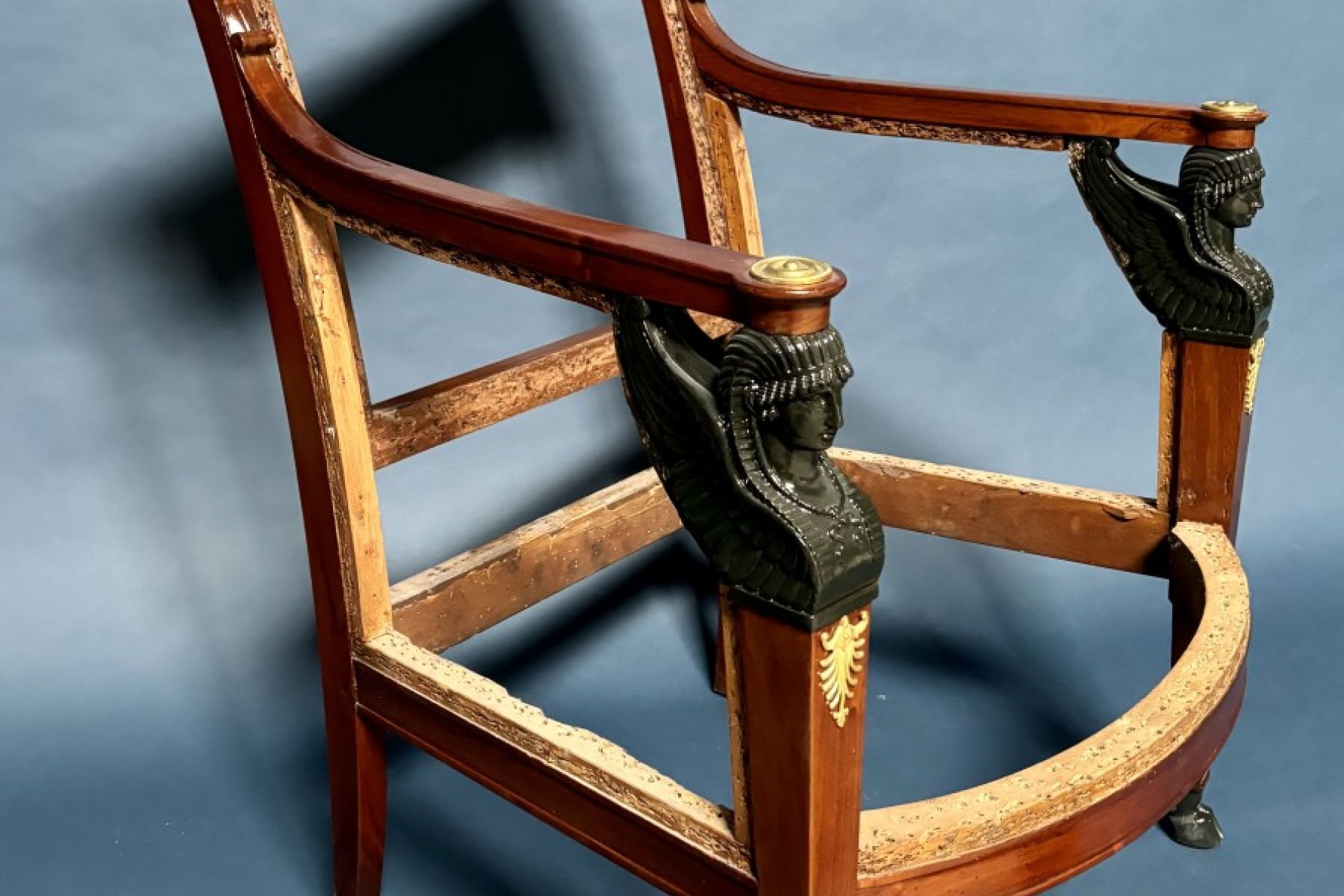Galerie Franck Baptiste
7 quai Voltaire
75007 Paris
FRANCE
Tél. +33 (0)6 45 88 53 58
Monday to Saturday
10h - 13h & 14h - 18h30
- FR
- EN

Chairs & Sofas
19th century
Bernard Molitor (1755-1833)
1
Chairs & Sofas du 19th century
Armchair with sphinxes attributable to Molitor, Paris ep Consulate
DIMENSIONS : l. 26.38 .inH. 35.43 .inP. 29.53 .in
MATERIAUX : Mahogany, ormolu
PROVENANCE : France, Paris
PRICE : 4 800 €
REQUEST INFORMATION
?Important armchair in mahogany veneer, solid mahogany, lacquered wood and mercury-gilded bronze.
“Antique” model, with an inverted backrest on saber legs at the rear and sheathed legs with sphinx heads topped with Nemes ending in doe hooves at the front.
Beautiful ornamentation of finely chiseled and gilded bronzes including heads of the god Mercury on the backs, rosettes on the armrests and falls of palmettes on the front uprights.
Very good state of conservation.
Parisian work attributable to Bernard Molitor, Consulate period, period of return from Egypt around 1798-1800.
Dimensions:
Width: 67 cm; Depth: 75 cm; Height: 90 cm
Molitor ébéniste de Louis XVI à Louis XVIII by Ulrich Leben, Éditions d’Art Monelle Hayot, 1992
Our opinion :
The shepherdess that we are presenting is extraordinary due to its large dimensions and its rare ornamentation of gilded bronzes.
It is attributable to the great cabinetmaker Bernard Molitor.
The diamonds of the backrests are recurrent in his production of seats, as are the masks that he positions in the center.
The latter are often in black-tinted carved wood but they can also be in bronze with an antique green patina or like here with a gold finish, depending on the degree of luxury chosen.
In addition to this characteristic shape, Bernard Molitor is the great specialist in the “hock” foot ending in animal paws.
It will also differentiate itself from the Jacob workshop by the originality of its models, sometimes with the heads of rams, lions, sphinxes ending in wild beast claws or, as here, small deer hooves.
To create a strong contrast, he will tint his caryatids and the tips of his feet.
We find this type of clogs on a rare chest of drawers with ram's heads, on a pedestal table with lion's muzzles or even on an Empire period bidet stamped by the master and which exactly mirrors our base.
All of its criteria make our attribution certain.
His stamp is extremely rare, he seems to have used it at the very end of the reign of Louis XVI and under the Empire but not at all under the Directory and the Consulate.
We know that he passed the revolution without the slightest problem, which suggests that he had to scrupulously respect the new laws of this troubled period, notably those which abolished corporations in 1791, putting an end to the obligation to stamp.
Unlike Georges Jacob who is a carpenter who will take advantage of this new law to produce furniture, Molitor is a cabinetmaker who will do the opposite by granting himself the privilege of producing seats.
In the same way that he enriched his pedestal tables, secretaries, etc. with gilded bronzes, he will continue on his seats, which makes them very precious but also very rare, because he seems to have only supplied his already existing clientele.
Indeed, at Molitor each set of seats is unique, probably made to measure for an order and not subsequently reissued.
This is what makes its production more confidential than that of the Jacob Frères company which will distribute repeat models in significant proportions.
This rarity, this originality, the preciousness of the materials used and the perfect execution make these seats particularly sought after by collectors.
Bernard Molitor (1755-1833)
Bernard Molitor est un ébéniste français né le 22 octobre 1755 à Betzdorf dans le Duché de Luxembourg et mort le 17 novembre 1833 à Fontainebleau.
Il est reçu maître ébéniste à Paris en 1787 et va trés vite séduire l'administration du Garde-Meuble de la Couronne dirigée par Thierry de Ville d'Avray.
Cette dernière est soucieuse de modérer les dépenses royales en remplaçant Jean Henry Riesener dont les factures mirobolantes passent de plus en plus mal.
A l’instar de l’élève de Oeben, il va produire des meubles aux formes trés sobres mais dans des bois de la meilleure qualité, simplement rehaussés de bronzes dorés trés fin.
Il ne sera pas ennuyé à la révolution et va même diversifier sa production en créant des sièges.
Sa production reprendra de plus belle sous l’empire et il prospérera jusqu’a la fin de sa vie avec du mobilier au style moins novateur que celui son apogée qui se situe entre 1790 et 1800.